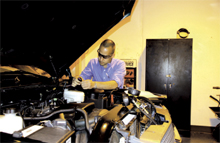Tips to prevent winter weather hazards


Robert Bolton/Pioneer
Brad Walker, professor of Automotive technology, works on a Chevy truck in the OCCC auto shop. Winterizing your car is the best defense against cold weather hazards.
Winter is on its way, and in Oklahoma that can mean ice, snow and freezing rain. Road conditions can be hazardous, and the worst possible time to find out one’s car has problems is out on the road in two feet of snow.
Avoiding such a scenario is the main reason that “winterizing,” or preventative maintenance with a focus on cold weather, is so important, said Brad Walker, automotive technology professor.
“Your vehicle’s only going to treat you as well as you treat it, and if you don’t maintain it, it will eventually leave you stranded,” Walker said.
Although such maintenance is important, getting it done properly is equally important.
“In some cases, the driver of the vehicle may know only where the gas goes, and how to start it,” Walker said.
Professor Walker’s Top Five Things to Winterize
1. Check your windshield wiper blades & fluid levels. Fluid without de-icer added can freeze, cracking the lines. Blades that have dried and cracked won’t be able to clear your windshield, and may leave you blind in bad conditions.
2. Antifreeze. Without the right antifreeze, and the right amount of anti-freeze, a car’s engine can freeze and crack from the inside out.
3. Oil change. In cold weather conditions, oil gets thicker. Having a new filter and clean oil of the right weight will improve starting and decrease stress on the car’s engine.
4. Battery. Cold weather can drain a battery, both from the increased density of the fluid inside, and from the extra effort a car needs to get started in the cold. Having the battery checked and replaced if necessary can prevent starting problems once cold weather hits.
5. Tire pressure. Changes in temperature change the pressure of the air both inside and outside the tire. Checking the pressure frequently can improve traction, and ensure that the tires aren’t wearing out too quickly from being underinflated.
And in those cases, a visit to a professional might be in order.
“Those that aren’t sure they know what they’re doing might not only fail to make it better, but there’s a chance you could actually make it worse.”
Ron Anderson, adjunct automotive technology professor, cites the many types of antifreeze on the market as one such potential pitfall.
“Not too long ago, there were maybe four or five types of antifreeze; now there are dozens,” Anderson said. “Knowing which one your car takes can be a challenge, and the wrong one can hurt your car badly.”
But for those who feel up to the challenge, Walker and Anderson have a few tips.
First, keep an eye on the tire pressure, Anderson said.
“You need to see if that pressure is adversely affected by the cold temperatures,” he said.
Walker agrees, and also notes checking the tire’s tread is a good way to avoid trouble.
“Easiest way is to take a penny and put it in your tread upside down, heads facing you,” Walker said.
“If you can see the top of (Abraham) Lincoln’s head, you need new tires. Those tires are not going to be able to get the traction you need, regardless of road conditions.”
Emergency Kit
When out on the road in wintery conditions, an emergency kit can make the difference between an annoyance and a long, cold wait for roadside service. Here are some expert suggestions from automotive Professors Walker and Anderson on what should go into your kit:
• Phone charger with a car adapter.
• Small shovel.
• Kitty litter, sand, or salt for extra traction.
• Warm clothes.
• Blanket.
• Flash light.
• Windshield de-icer and scraper.
Another issue to watch for is one which might be easily forgotten until it’s too late, Walker said.
“Wiper blades. Especially as dry a summer as we’ve had, your windshield wiper blades will get dry and crack, and you may not realize it until the roads get a little wet and freeze,” he said.
“And once that salt hits the roads, once you get behind a truck and it starts throwing spray on your windshield, you can’t see because the wipers can’t clear it,” Walker said.
Anderson also said cars tend to be under far more stress in cold weather than warm.
“If there’s a service light blinking, you don’t want to put that off.
“A small problem now can become a big problem once the cold sets in,” Anderson said.
Anderson recommends getting an oil change, and checking all fluid levels thoroughly to ensure a vehicle is up to that stress.
“When the temperature drops, every single fluid in that engine gets denser. It’s harder to start and harder to run until it warms up, because it takes more to push those fluid through the engine,” he said.
Walker also said a quick check of the belts, especially the serpentine belt, is a good way to avoid trouble.
“What you want to do is make sure there’s not too much cracking. Three cracks or more per inch of belt, and it needs to be replaced.”
Finally, both Anderson and Walker recommend keeping an emergency kit in one’s car.
“Even a properly maintained vehicle can break down, and if that happens and you get stranded, you’re going to want some warm clothes or a blanket, and a flashlight at the very least,” Walker said.
To contact Jeremy Cloud,
email editor@occc.edu.